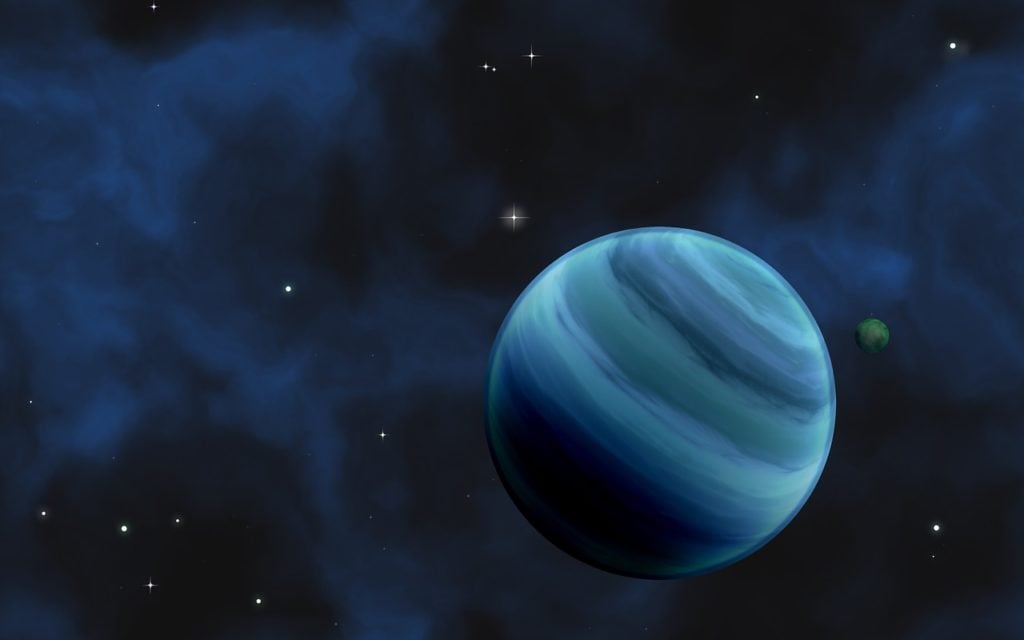Finding an exoplanet to support life similar to our Earth is often referred to as searching for a needle in a haystack. However, scientists have discovered that exoplanets rich in water, one of the main compounds for life, are more common than we think. They presented their work at the Goldschmidt Conference in Boston. Their work suggests that exoplanets rich in water are usually from two to four times larger than Earth.
Huge surprise!
Exoplanets that orbit their respective host stars were discovered in 1992, and their discovery triggered the need for understanding what those planets are made of, and if they are suitable for hosting life as we know it. The data gathered from the Kepler Space Telescope and the Gaia mission suggests that many exoplanets that were previously discovered could contain as much as 50 percent water, as opposed to Earth’s 0.02 percent water content, measured by weight.
“It was a huge surprise to realize that there must be so many water-worlds,” lead researcher Dr. Li Zeng (Harvard University), said at the conference, as per Phys.org.
Out of the 4000 confirmed or candidate exoplanets found by the space telescope, scientists discovered that there are two size categories: the ones with a planetary radius of about 1.5 that of the Earth, or those being 2.5 times the radius of the Earth on average.
The international team of scientists analyzed those exoplanets and compared their mass measurements, as well as recent radius measurements from the Gaia satellite. The analysis helped them create a model that studies the exoplanets rich in water.
“We have looked at how mass relates to radius, and developed a model which might explain the relationship,” said Li Zeng. “The model indicates that those exoplanets which have a radius of around x1.5 Earth radius tend to be rocky planets (of typically x5 the mass of the Earth), while those with a radius of x2.5 Earth radius (with a mass around x10 that of the Earth) are probably water worlds.”
“This is water, but not as commonly found here on Earth,” Li Zeng added. “Their surface temperature is expected to be in the 200 to 500 degree Celsius range. Their surface may be shrouded in a water-vapor-dominated atmosphere, with a liquid water layer underneath. Moving deeper, one would expect to find this water transforms into high-pressure ices before we reaching the solid rocky core. The beauty of the model is that it explains just how composition relates to the known facts about these planets.”
The researcher also explained that based on the data the team collected, about 35% of all known exoplanets that are larger than Earth should contain water. The data suggests that those water worlds, could have formed similar to the giant planet cores such as Jupiter, Saturn, Uranus and Neptune.
TESS Mission To Assist The Discovery
It’s likely that the recently launched TESS mission is going to discover even more water-rich worlds, as well as the next generation of space telescope, the James Webb Space Telescope once it launches.
Sara Seager, Professor of Planetary Science at Massachusetts Institute of Technology, and deputy science director of the newly-launched TESS (Transiting Exoplanet Survey Satellite) mission, which will search for exoplanets, said: “It’s amazing to think that the enigmatic intermediate-size exoplanets could be water worlds with vast amounts of water. Hopefully atmosphere observations in the future—of thick steam atmospheres—-can support or refute the new findings.”
What makes a planet habitable?
Exoplanets rich in water only are not necessarily habitable, as more criteria needs to be met. We can assume that a habitable planet is Earth-like. However, it doesn’t have to be. In fact, astrobiologists suggest that there should be about 500 habitable planets that could support extraterrestrial life. That said, even in our own galaxy, there is a possibility that we are not alone.
According to Learn.Genetics, there are additional conditions that need to be satisfied other than the planet having plenty of liquid water on its surface. First, there needs to be a comfortable distance between the star and the planet. The planet needs to be far enough away, not to be too hot and exposed to too much radiation, yet not too far away so that it would be extremely cold for survival.
The planet needs to have a rocky surface. Planets like Jupiter, Saturn and Uranus are planets made out of gases, which means life stands no chance on such planets. The planets also need to be large enough and have a “molten core.” Earth has a core that sources the planet with geothermal energy, allows cycling of raw material, and sets up the magnetic field around the planet so that it would be protected from the radiation from nearby stars. Also, the protective atmosphere that is capable of holding carbon dioxide and other gases from escaping is more than essential. Such an atmosphere keeps the planet warm and also protects it from radiation.
Lastly, similar to Earth that has Jupiter and Saturn in its neighborhood, the perfect Earth-like exoplanets rich in water need to have some giants around that can attract the asteroids and other rocks that could jeopardize life on the planet with their massive gravity.
However, it’s still hard to say whether there is intelligent life on those planets. Life on Earth has been microbial for a long time. Microbes have been present on Earth for 3.5 billion years, while the earliest rocks on Earth formed roughly 3.8 billion years ago.
While it’s possible that life could exist on other exoplanets in our galaxy, it’s still unknown what form of life that could be.












